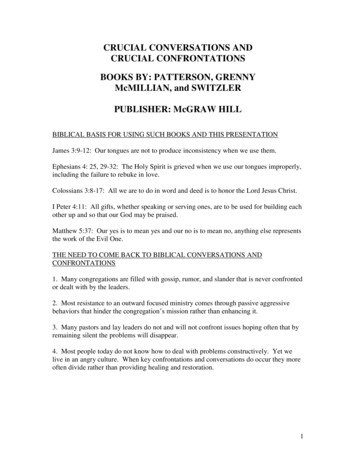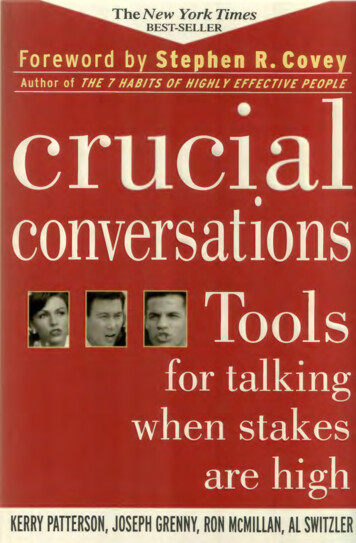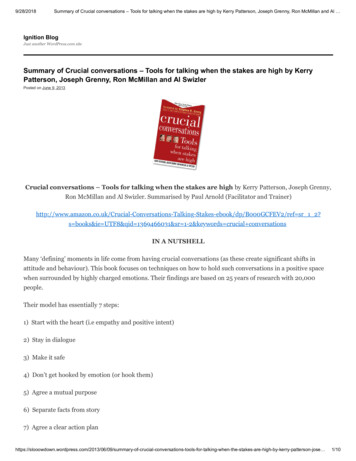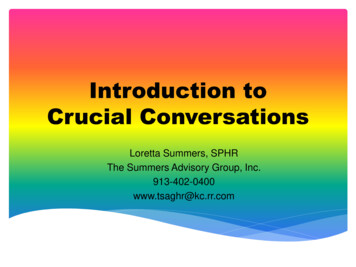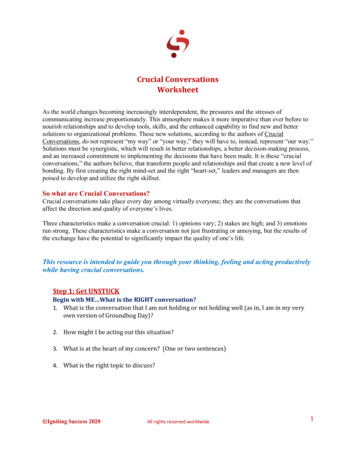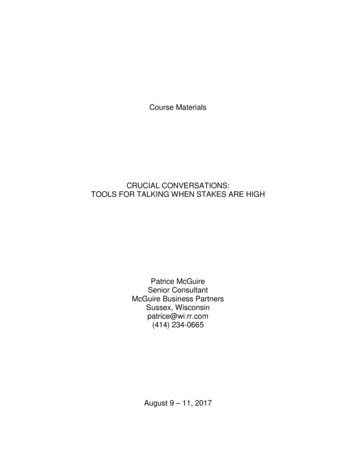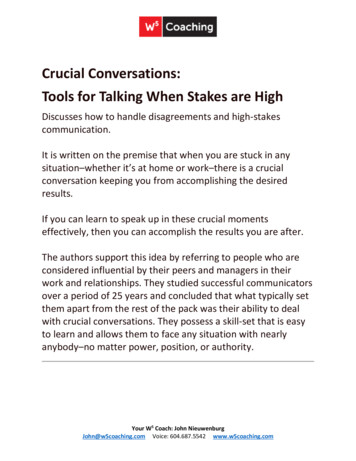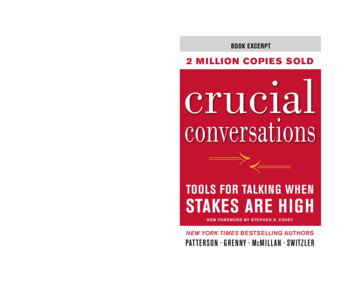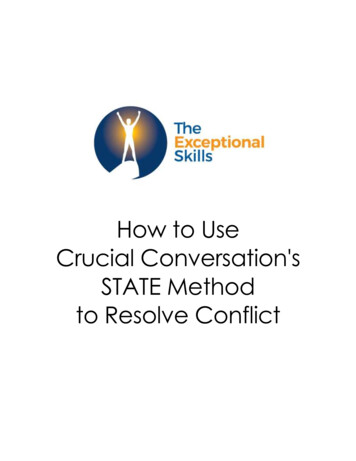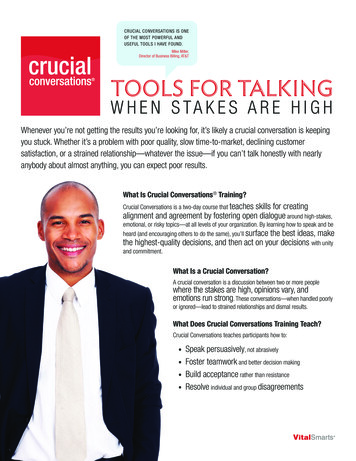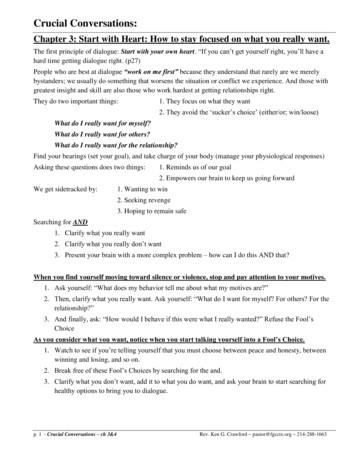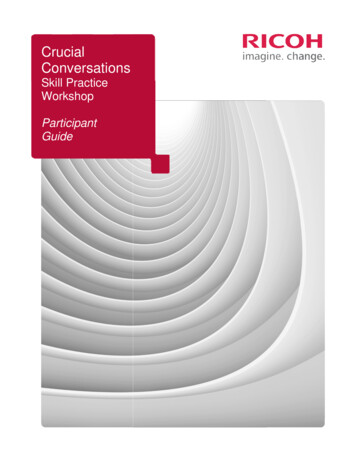
Transcription
icipantGuide
Crucial ConversationsApril 20, 2015AGENDA1. Identifying High Stakes Conversations and Assessing yourEffectiveness2. Start with the Heart3. Learn to Look4. Make it Safe5. Master Your Stories6. STATE Your Path7. Explore Others’ Paths8. Move to Action9. Putting It All Together2
Crucial ConversationsApril 20, 2015What is a Crucial Conversation?A discussion between two or more people where(1) stakes are high,(2) opinions vary, and(3) emotions run strong.ExerciseExerciseDescribe the last cruccrucialial conversation you had at HOME.HOME Whathappened? What worked and didn’t work? What would you dodifferently if you could?Describe the last cruccrucialial conversation you had at WORK.WORK Whathappened? What worked and didn’t work? What would you dodifferently if you could?3r
Crucial ConversationsApril 20, 2015What are our choices in handling Crucial Conversations?1.2.3.We can avoidvoid them.We can face them and handle them poorly.We can face them and handle them well.Why do we typically handle them poorly or avoid them?1. We’re designed wrong – emotions don’t prepare us toconverse effectively.2. We’ree’re under pressure – we react rather than think it through.3. We’re stumped – we haven’t faced this before.4. We act in self-defeatingdefeating ways – the more you respond, themore you exacerbate the problem.THE FOOL’S CHOICEEITHEROPTION ONE: TELL THE TRUTH AND TURN THE PERSONPINTO AN ENEMY.OROPTION TWO: KEEP SILSILENT, PRESERVE THE RELATIONSHIP,RELATIOAND LEAVE THE PROBLEPROBLEM UNRESOLVED.4r
Crucial ConversationsApril 20, 2015START WITH THE HEART1. Work on “Me” first, “Us” second.2. Recognize Moments of Truth– Realize when a conversation is about to turn crucial– Start with the Right MotivesNo WINNINGNo PUNISHINGNo KEEPING THE PEACE (AVOIDANCE)– Stay focused no matter what happens.3. Three Steps to SuccessI. Clarify what it is you really want:What do I really want for myself?What do I really want for others?What do I really want for the relationship?II. Clarify what it is that you don’t want:What are the bad outcomes of playing to win, punishing,or avoidance?III. Search for the elusive “AND”: How can I get what I want ANDavoid what I don’t want?Notes:5r
Crucial ConversationsApril 20, 2015LEARN TO LOOKSilenceMasking – understating orselectively showing your trueopinion (sarcasm,sugarcoating)Avoiding – steering awayfrom sensitive subjectsWithdrawing – avoiding theconversation completelyNotes:ViolenceControlling – coercing othersinto your way of thinkingLabeling – putting a label onpeople or ideas so we candismiss them under astereotypeAttacking – moving fromwinning the argument tomaking the other person suffer(belittling, threatening)6r
Crucial ConversationsApril 20, 2015LEARN TO LOOKSTYLE UNDER STRESSThis 33-questionquestion assessment allows you to see how you respond in crucial conversations in aspecific relationship. The results indicate your natural tendencies to move toward silence orviolence as well as the dialogue skills or tools you use well or need improvement in.The following questions explore how you typically respond when you’re in the middle of astressful situation.Instructions: Relationship. Before you get started, think about the relationship you want to explore—explorewith your boss, a coworker,rker, a direct report, a friend, or family member—keepmemberthisrelationship in mind.Circumstance. Next, think of a tough circumstancecircumstance—oneone where you might slip into eithersilence or violence.Apply. Now, with that relationship and circumstance in mind, resrespondpond to the followingstatements as either true or false.True FalseTrue FalseTrue FalseTrue FalseTrue FalseTrue FalseTrue False1. At times I avoid situations that might bring me into contact with peopleI’m having problems with.2. I have put off returning phone calls or ee-mailsmails because I simply didn’twant to deal with the person who sent them.3. Sometimes when people bring up a touchy or awkward issue I try tochange the subject.4. When it comes to dealing with awkward or stressful subjects, sometimesI hold back rather than give my full and candid opinion.5. Rather than tell people exactly what I think, sometimes I rely on jokes,sarcasm, or snide remarks to let ththemem know I’m frustrated.6. When I’ve got something tough to bring up, sometimes I offer weak orinsincere compliments to soften the blow.7. In order to get my point across, I sometimes exaggerate my side of theargument.7r
Crucial ConversationsTrue FalseTrue FalseTrue FalseTrue FalseTrue FalseTrue FalseTrue FalseTrue FalseTrue FalseTrue FalseTrue FalseTrue FalseTrue FalseApril 20, 20158. If I seem to be losing control of a conversation, I might cut people off orchange the subject in order to bring it back to where I think it should be.9. When others make points that seem stupid to me, I sometimes let themknow it without holding back at all.10. When I’m stunned by a comment, sometimes I say things that othersmight take as forceful or attackingattacking—termsterms such as “Give me a break!” or“That’s ridiculous!”11. Sometimes when things get a bit heated I move from arguing againstothers’ pointsoints to saying things that might hurt them personally.12. If I really get into a heated discussion, I’ve been known to be tough onthe other person. In fact, they might even feel a bit insulted or hurt.13. When I’m discussing an important topic with others, sometimes I movefrom trying to make my point to trying to win the battle.14. In the middle of a tough conversation, I often get so caught up inarguments that I don't see how I'm coming across to others.15. When talking gets tough and I do something hurtful, I’m quick toapologize for my mistakes.16. When I think about a conversation that took a bad turn, I tend to focusfirst on what I did that was wrong rather than focus on others’ mistakes.17. When I’ve got something to say that others might not want to hear, Iavoid starting out with tough conclusions, and instead start with facts thathelp them understand where I’m coming from.18. I can tell very quickly when others are holding back or feeling defensivein a conversation.19. Sometimes I decide that it’s better not to give harsh feedback because Iknow that it’s bound to cause real problems.20. When conversations aren’t working, I step back from the fray, think aboutwhat’s happening, and take steps to make it better.8r
Crucial ConversationsTrue FalseTrue FalseTrue FalseTrue FalseTrue FalseTrue FalseTrue FalseTrue FalseTrue FalseTrue FalseTrue FalseTrue FalseTrue FalseApril 20, 201521. When others get defensive because they misunderstand me, Iimmediately get us back on track by clarifying what I do and don’t mean.22. There are some people I’m rough on because, to be honest, they needor deserve what I give them.23. I sometimes make absolute statements like “The fact is ” or “It’sobvious that ” to be sure my point gets across.24. If others hesitate to share their views, I sincerely invite them to saywhat’s on their mind, no matter what it is.25. At times I argue hard for my view hoping to keep others from bringing upopinions that would be a waste of energy to didiscussscuss anyway.26. Even when things get tense, I adapt quickly to how others areresponding to me and try a new strategy.27. When I find that I’m at cross purposes with someone, I often keep tryingto win my way rather than looking for common ground.28. When things don’t go well, I’m more inclined to see the mistakes othersmade than notice my own role.29. After I share strong opinions, I go out of my way to invite others to sharetheir views, particularly opposing ones.30. When others hesitate to share their views, I do whatever I can to make itsafe for them to speak honestly.31. Sometimes I have to discuss things I thought had been settled because Idon't keep track of what was discussed before.32. I find myself in situations where people get their feelings hurt becausethey thought they would have more of a say in final decisions than theyend up having.33. I get frustrated sometimes at how long it takes some groups to makedecisions because too many people are involved.9r
Crucial ConversationsApril 20, 2015LEARN TO LOOKWhat Your Style Under Stress Score MeansYour silence and violence scores give you a measure of how frequently you fall into these lessthan-perfectperfect strategies. It’s actually possible to score high in both. A high score (one or twochecked boxes per domain means you use this technique fairly often.SilenceTotalMasking5 (T)6 (T)ViolenceTotalControlling7 (T)8 (T)Avoiding3 (T)4 (T)Labeling9 (T)10 (T)Withdrawing1 (T)2 (T)Attacking11 (T)12 (T)Score Sheet for Dialogue Skills AssessmentThe seven domains below reflect your skills in each of the corresponding seven skill chapters. Ifyou score high (two or three boxes) in one of these domains, you’re already quite skilled in thisarea. If you score low (zero or one), you may want to pay special attention to these chapters.Ch 3: Start with the Heart13 (F)19 (F)25 (F)Ch 4: Learn to Look14 (F)20 (T)26 (T)Ch 5: Make it Safe15 (T)21 (T)27 (F)Ch 6: Master My Stories16 (T)22 (F)28 (F)Ch 7: STATE My Path17 (T)23 (F)29 (T)Ch 8: Explore Others Paths18 (T)24 (T)30 (T)Ch 9: Move to Action31 (F)32 (F)33 (F)10r
Crucial ConversationsApril 20, 2015MAKE IT SAFEGuiding Principles1. Step Out, Make it Safe, Step Back In2. Notice which Condition is at RiskMutual Purpose – the Entrance ConditionWhy talk in the first place?A. Do others believe I care about their goals inthis conversation?B. Do they trust my motives?Mutual Respect – the Continuance ConditionWill we be able to remain in Dialogue?A. Do others believe I respect them?What To Do Once You Step Out1. Apologize when Appropriate– Sincere .or don’t bother2. Contrast to Fix Misunderstanding (Don’t / Do)– Address other’s concerns that you don’t respect them or that you havemalicious purpose: What you don’t intend or mean.(I didn’t intend to leave the impression .)– Confirm your respect or clarify your real purpospurpose: What you do intend ormean. (II really do believebelieve.)3. Create a Mutual Purpose (CRIB)– Commitommit to Seek Mutual Purpose– Recognizeecognize the Purpose Behind the Strategy– Inventnvent a Mutual Purpose– Brainstormrainstorm New StrategiesNotes:11r
Crucial ConversationsApril 20, 2015MAKE IT SAFEContrasting Role PlaysExample: “I don’t want you to think I’m saying that I can’t count on you. I find you to be quitereliable. I do, however, have concerns over what happened with yesterday’s deadline.”Role Play 1—The Raw Meat: You just told your spouse that the meat he or she just prepared onthe grill is “a bit too rare for your taste.” Your spouse comes back sharply with: “Sounds like you think you’re the big cooking expertnow!”Reply with a Contrasting statement. This time your spouse says: “I do my best and it’s never good enough for you!” Reply with aContrasting statement. This time your spouse says with a look of pain: “I thought you liked the way I cook.” Reply with aContrasting statement.Role Play 2—TheThe Messy Cubicle. You’ve just told a person who shares an office cubicle withyou that you’d rather she not leave her pizza boxes, Chinese food containers, and other lunchmaterials on your desk. She abruptly responds: “Oh I get it, now that you’ve been awarded employee of the month youthink you can boss me around.” Reply with a Contrasting statement. This time your coworker says with a hurt expression: “I thought we were a team. I thought thatwe worked really well together. What happened?” Reply with a Contrasting statement.statement This time, prepare a Contrasting statement that you might say before you mention anythingabout the lunch mess. What would you say to avoid any misunderstanding? Offer an up-frontupContrasting statement.Role Play 3—TheThe “Joking” Boss. Your boss often teaseseases you about your weight by calling you“chubby,” “hefty,” and the like. This is supposed to be ironic because you’re actually very thin.He’s good natured about it and you don’t think he means any harm, but you don’t like it. Finallyyou mustered up thee nerve and suggested that you’d prefer he not refer to your weight. He comes back with: “What, you can’t take a joke?” Reply with a Contrasting statement. This time your boss says: “I’m sorry. I didn’t realize I was such an awful boss.” Reply with aContrasting statement.This time your boss says: “I guess I need to be hiring a lawyer.” Reply with a Contrastingstatement.12r
Crucial Conversations13rApril 20, 2015MASTER YOUR STORIESStories Create FeelingsNothing in this world is good or bad, but thinking makes it so.W. ShakespeareSkills for Mastering Our Stories1. Notice Your Behavior (AmAm I in some form of silence or violence?)2. Get in touch with your Feelings (What emotions are leading me to act this way?)Analyze Your Stories (What story is creating these emotions?)Victim Stories – “Its not my fault”Villain Stories – “Its all your fault”Helpless Stories – “There’s nothing else I can do”3. Get Back to the Facts (What evidence do I have to support this story?)The Remedy: Tell the Rest of the StoryAsk: Am I pretending not to notice my role in the problem?Why would a reasonable, rational, and decent person do this?What do I really want?What would I do right now if I really wanted these results?Notes:
Crucial ConversationsSTATE YOUR PATHNotes:April 20, 201514r
Crucial ConversationsApril 20, 2015STATE YOUR PATHSTATE Role PlaysRole Play 1—TheThe Nasty Hints. Your spouse is a high-energyenergy workaholic who gets more done inone day than most people get done in two. You’re a decent worker but don’t see the need toalways work at light speed. Over the last few weeks your spouse has been dropping hints thatsound as iff maybe he or she thinks you don’t have very good work habits. “Way to go pokey!” or“So you finally made it out of bed,” or “Maybe I should do it if I want to see it done right.” Whenyou asked what he or she meant by the snide remarks, your spouse said iitt was just a joke. Itdoesn’t seem like a joke to you. It’s time to say something.STATE your path. Sharehare your facts (Here’s what you’ve said and done . . .) Tellell your story (This is what I’m beginning to conclude. . .) Ask for your spouse’s pathMake sure you Talk tentatively and Encourage testing.Role Play 2—TheThe Backup CoverCover-up. Hannah, one of your computer experts at work, isresponsible for backing up your network files each day. That way if your equipment crashes, younever lose more than a day’s work. This is an important but moderately annoying task. You thinkshe may not actually be doing it all of the time. Here’s your evidence. Twice when you askedHannah if she had backed up the system, she said she would do it later on, only you never sawher do it. You only saw her go home. The last time you asked her if she’s doing the job she said,“sort of,” but when you asked her what that meant, she told you not to worry. When she was sicklast week you have no evidence that she asked someone to ffill in for her. You’ve decided to saysomething but don’t want to make a false accusation.STATE your path. Sharehare your facts (Here’s what you’ve said and done . . .) Tellell your story (This is what I’m beginning to conclude. . .) Ask for your coworker’s pathMake sure you Talk tentatively and Encourage testing.Role Play 3—TheThe Unwanted Promotion. Your boss Chris keeps telling you that you’d make agreat supervisor. You don’t want the promotion. You like what you do. Period. Chris said teamplayers take promotions. Period. You’ve heard that Chris is submitting the paperwork to have youpromoted. Yesterday Chris said you’d soon be getting a big surprise. This morning he asked youto be sure to go to the afternoon team meeting. You don’t want him to sprispringng the announcementin the meeting and pressure you.You’ve decided to STATE your path. Sharehare your facts (Here’s what you’ve said and done . . .) Tellell your story (This is what I’m beginning to conclude. . .) Ask for your boss’s pathMake sure you Talk tentatively and Encourage testing.15r
Crucial ConversationsApril 20, 2015EXPLORE OTHERS’ PATHPATHSPower Listening Tools (AMPP)1. Ask to Get Things Rolling2. Mirror to Confirm Feelings3. Paraphrase to Acknowledge the Story4. Prime when you’re Getting NowhereRemember Your ABC’sAgree – if you agree with the other person’s path, say so and move on. Don’t turn anagreement into an argument.Build – if you agree with most of what has been said, but it is incomplete – point out theareas of agreement, and then add elements that were left out.Compare – point out that your view is different – not that theirs is wrong. Don’t turndifferences into debates.Notes:16r
Crucial ConversationsApril 20, 2015EXPLORE OTHERS’ PATHPATHSExplore Others’ Paths Role PlaysRole Play 1—YourYour Irate Neighbor. Your next-doordoor neighbor pounds on your door. When youopen it, heappears to be boiling mad. Sure enough, when he opens his mouth he says: “I’m so mad at you Icouldspit nails.”Ask. (State aloud a question that will encourage him to say exactly what’s going on.)He comes back with. “Never mind, I guess I’m okay,” and turns to walk away.Mirror. (Describe his apparent anger and explain that it suggests that maybe he isn’t okay.)To this he says: “Now that I think about it, I’m not sure I want to bring this up. Sometimes it’s besttoleave things unsaid.”Paraphrase. (Restate in your own words what he said in order to keep the conversation alive.)He responds with: “It’s just that your stupid mutt . . . oh never mind. I don’t want to cause trouble.”You wonder if your dog got into his yard and dug up his flowers again.Prime. (Take a guess at what you think has him so angry.)Role Play 2—TheThe Disgusted Coworker. You’re sitting at your desk reviewing your e-mailewhena womanan who works in your office walks up to you and says. “I’m up to your tricks. One moretime and I’m submitting a complaint.” You don’t know what she’s talking about.Ask.She comes back with. “You don’t know, or don’t care? Well if you don’t care, I don’t care.”Mirror.To this she says: “How come I’m the one who does all the dirty work?”Paraphrase.She responds with: “Exactly. You have seniority, so I have to do the tedious parts of your job!”You asked her to write the weekly newsletter a couple of times (a job everyone hates) andwonder if this has her upset.Prime.Role Play 3—Mix and Match. Use the AMPP skill or skills of your choice in response to thefollowing statements.“You come prancing in here like you own the place.”“Never mind; if you think the white one looks better; I guess you know what’s best.”“You’re not going to actually send out that letter are you?”(Looking upset and discouraged.) “Don’t worry. I’m just fine.”“What in the name of Aunt Hilda’s goat were you thinking?”“One more stunt like that and I’m going to the boss.”17r
Crucial ConversationsApril 20, 2015MOVE TO ACTIONFour Methods of DecisionDecision-Making1. Command – decision made without involving others2. Consult – input gathered then a subset or one decides3. Vote – an agreed upon percentage swings the decision4. Consensus – everyone comes to agreement and then supports the final decision.Which Decision-MakingMaking Method is Best?Four Important Questions1. Who cares? (desire)2. Who knows? (expertise)3. Who must agree? (stakeholders)4. How many peoplele is it worth involving? (fewest possible to get quality outcome)Finish Clearly Who? Does What? By When? How will you Follow up?HOLD PEOPLE ACCOUNTABLE TO THEIR PROMISES!18r
Crucial ConversationsApril 20, 2015PUTTING IT ALL TOGETTOGETHER1. Identify your next crucial conconversation at work:2. What is the Dialogue you want to create?3. What is the Mutual Purpose you want to create? How will you establish mutual respect? What is your tendency – Silence or Violence – when conversations turnstressful? How will you avoid that tendency?4. What is your current Story regarding this individual? Is it Villain, Victim, or Helpless?5. STATE your path: Share your facts Tell your story Ask for others' paths Talk tentatively Encourage testing6. How do you intend to move to action – clarifying next steps?Exercise19r
Crucial Conversations20rApril 20, 2015NOTESSlide 1EstablishedLeader Training:CommunicationsCrucial ConversationsApplication WorkshopSlide 2Meeting Courtesy Be courteous to your fellow participants To eliminate background noise put your phoneon mute *6 To speak – unmute #6 Please DO NOT put your phone on HOLD!Slide 3Participating in the WebExSession Rules of Engagement WebEx Functionality– Participant List– Raising Hand– Yes/No– Chat Functionality Cold Calling
Crucial Conversations21rApril 20, 2015Slide 4Your Hosts for Today’sSession InsertPhotoLEARNINGLEARNINGSPECIALISTTRICOH USAUSARICOH4Slide 5Introductionsruns Function/Role Location Key take-away from eLearning pre-workFO R I NTERNALSlide 6USE O NLY - DO NO T DI STRI BUTEO UTSI DEO F RI CO H5Preparing for CrucialConversations Takes Practice Start With Heart Learn to Look Make It SafeMaster Your StoriesSTATE My PathExplore Others’ Paths Move to ActionFO R I NTERNALUSE O NLY - DO NO T DI STRI BUTEO UTSI DEO F RI CO H6
Crucial ConversationsSlide 722rApril 20, 2015The Messy Cubicle Betsy is a co-worker that shares an office cubiclewith you. You enjoy working with her becauseshe is a real “team player” who is always willingto put in the extra effort to get the job done. Onething about Betsy bothers you, though. Hercubicle is littered with pizza boxes, Chinese foodcontainers, and other lunch materials.Sometimes, there is so much clutter that it getspushed over on your side of the desk. The messstinks, and you worry that it will soon begin toattract bugs!FO R I NTERNALSlide 8USE O NLY - DO NO T DI STRI BUTEO UTSI DEO F RI CO H7Apply the CrucialConversation Skills Start With Heart– What result do you want from having thisconversation with Betsy?– What do you NOT want to happen as a result ofhaving this conversation with Betsy?FO R I NTERNALSlide 9USE O NLY - DO NO T DI STRI BUTEO UTSI DEO F RI CO H8Oh Yeah . She abruptly responds: “Oh I get it, now thatyou’ve been awarded employee of the monthyou think you can boss me around.”FO R I NTERNALUSE O NLY - DO NO T DI STRI BUTEO UTSI DEO F RI CO H9
Crucial ConversationsSlide 1023rApril 20, 2015Apply the CrucialConversation Skills Learn to look– What do you think Betsy’s style under pressure issilence, violence or masking?– What is YOUR style under pressure?FO R I NTERNALSlide 11USE O NLY - DO NO T DI STRI BUTEO UTSI DEO F RI CO H10Apply the CrucialConversation Skills Make it Safe– Should you apologize?– Should you use a contrasting statement?– Why is safety at risk?FO R I NTERNALSlide 12USE O NLY - DO NO T DI STRI BUTEO UTSI DEO F RI CO H11The Mess Continues Betsy looks more thoughtful, and asks, “So howdoes the mess on my desk affect others?”FO R I NTERNALUSE O NLY - DO NO T DI STRI BUTEO UTSI DEO F RI CO H12
Crucial Conversations24rApril 20, 2015Slide 13Apply the CrucialConversation Skills Master your Stories– Villain– VictimFO R I NTERNALSlide 14USE O NLY - DO NO T DI STRI BUTEO UTSI DEO F RI CO H13Apply the CrucialConversation Skills– Share your facts– Tell your story– Ask for others’ paths– Talk tentatively– Encourage Testing“Honestly, I have been trying so hard to meetthe deadlines with our project that I haven’tgiven much thought to cleaning up after myself.We are so busy, we eat at our desks. We havepaper everywhere already. I figure; what’s alittle more clutter ”FO R I NTERNALSlide 15USE O NLY - DO NO T DI STRI BUTEO UTSI DEO F RI CO H14Apply the CrucialConversation Skills Explore others’ path(s)“I guess I can make it a point to take all of my foodcontainers to the garbage can in the break room eachday before I leave, but I really don’t have time to dothis 3-4 times per day.”15FO R I NTERNALUSE O NLY -DO NO T DI STRI BUTEO UTSI DE O F RI CO H
Crucial ConversationsSlide 1625rApril 20, 2015Apply the CrucialConversation Skills Move to Action“I will take all of my garbage and any garbage youmay have to the trash as I leave each evening.Then, each day after lunch you will take yourgarbage and mine to the trash can.”FO R I NTERNALSlide 17USE O NLY - DO NO T DI STRI BUTEO UTSI DEO F RI CO H16The Speeder You are returning from lunch and as you arewalking in the parking lot you see Fred speedingout of the parking lot on his motorcycle doingabout 40 mph. Fred is not your employee. Aboutan hour later, you see Fred in the warehouseand you feel it is time to approach him about it.FO R I NTERNALSlide 18USE O NLY - DO NO T DI STRI BUTEO UTSI DEO F RI CO H17Slow Down – Start with Heart What result do you want from having this conversationwith Fred? What do you NOT want to happen as a result of havingthis conversation with Fred?FO R I NTERNALUSE O NLY - DO NO T DI STRI BUTEO UTSI DEO F RI CO H18
Crucial ConversationsSlide 1926rApril 20, 2015Sitting Idle . Fred does not respond to you, rather he standsthere staring at you with his arms crossed.FO R I NTERNALSlide 20USE O NLY - DO NO T DI STRI BUTEO UTSI DEO F RI CO H19Learn to Look What do you think Fred’s style under pressure issilence, violence or masking? What is YOUR style under pressure?FO R I NTERNALSlide 21USE O NLY - DO NO T DI STRI BUTEO UTSI DEO F RI CO H20Make it Safe Should you use a contrasting statement? Should you apologize? Why is safety at risk?FO R I NTERNALUSE O NLY - DO NO T DI STRI BUTEO UTSI DEO F RI CO H21
Crucial ConversationsSlide 2227rApril 20, 2015Mind your own business Fred says, “How I ride my bike and safety is notyour concern. You aren’t my boss, so mind yourown business.FO R I NTERNALSlide 23USE O NLY - DO NO T DI STRI BUTEO UTSI DEO F RI CO H22What’s the Story . Master your Stories– Villain– VictimFO R I NTERNALSlide 24USE O NLY - DO NO T DI STRI BUTEO UTSI DEO F RI CO H23STATE Your Path– Share your facts– Tell your story– Ask for others’ paths– Talk tentatively– Encourage Testing“We only have a limited amount of time forlunch and I had a lot to do during that hourtoday ”FO R I NTERNALUSE O NLY - DO NO T DI STRI BUTEO UTSI DEO F RI CO H24
Crucial Conversations28rApril 20, 2015Slide 25STATE Your Path– Share your facts– Tell your story– Ask for others’ paths– Talk tentatively– Encourage Testing“We only have a limited amount of time forlunch and I had a lot to do during that hourtoday ”FO R I NTERNALSlide 26USE O NLY - DO NO T DI STRI BUTEO UTSI DEO F RI CO H25What Roads Can We Take Explore others’ path(s)“I guess I can slow down when I am in the parking lot,but there might be another time when I’m feelingrushed to get back in time from lunch. You know howmonth-end can get.”26FO R I NTERNALSlide 27USE O NLY -DO NO T DI STRI BUTEO UTSI DE O F RI CO HApply the CrucialConversation Skills Move to Action“I will slow down in the parking lot, and if I amconcerned about making it back from lunch in time Iwill speak with manager ahead of time so we candeal with it at that time ”FO R I NTERNALUSE O NLY - DO NO T DI STRI BUTEO UTSI DEO F RI CO H27
Crucial ConversationsSlide 2829rApril 20, 2015Your Last Crucial Conversation Success Needed some workFO R I NTERNALSlide 29USE O NLY - DO NO T DI STRI BUTEO UTSI DEO F RI CO H28Post-Work/ChecklistWork/Checklist ActivityAction PlanFO R I NTERNALSlide 30USE O NLY - DO NO T DI STRI BUTEO UTSI DEO F RI CO H29
Crucial Conversations April 20, 2015 2 AGENDA 1. Identifying High Stakes Conversations and Assessing your Effectiveness 2. Start with the Heart 3. Learn to Look 4. Make it Safe 5. Ma
